The old mining communities of Cwmamman, Garnant and Glanamman sit in the Amman Valley, on the Eastern edge of Carmarthenshire. These and the immediate surrounding villages contributed many men to the war effort, and also lost many of these men. They are remembered on this page. As there were originally no names on the War Memorial at Cwmamman, the rolls of names were taken from the 1922 Carmarthen County War Memorial pamphlet, and also from other men who I have found to have lived locally. Since the publication of this information on my website, a new memorial has since been erected with these same names on. Thanks to Dave Michael and to Paul Sambrook for their valuable assistance.
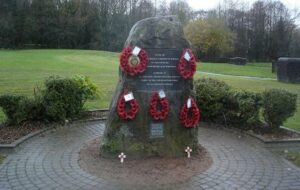
The Great War, 1914-1918
Tom Bassett, Private, 12389, Royal Welsh Fusiliers. Tom was the son of William and Ann Bassett, of Brynamlwg, Garnant. He enlisted at Ammanford into the 8th Battalion, Royal Welsh Fusiliers, who were attached to 40 Brigade, 13th (Western) Division. The Division left for Alexandria in June, 1915, and then landed at Cape Helles in July. They fought throughout the remainder of the Gallipoli debacle, before being evacuated to Egypt in January, 1916, and in February moved into Mesopotamia to attempt the relief of the Siege of Kut. The Division fought throughout the entire campaign in Mesopotamia, which is where Tom sadly died of sickness on 22 June 1918. He was 22 years old, and is buried at Baghdad (North Gate) War Cemetery, Iraq.
Zachariah Beech, Private, 57957, Royal Welsh Fusiliers. Zacharia was the son of Zacharia and Elizabeth Rees, of 2, Ceidrim Road, Glanamman. He enlisted at Carmarthen into the Welsh Regiment and was posted to France, probably in 1917, where he was posted to the 13th Battalion, Royal Welsh Fusiliers, which were attached to 113 Brigade, 38th (Welsh) Division. The Division had been in France since December 1915, and had famously captured Mametz Wood in 1916. The Division suffered terrible casualties at Mametz, and were taken out of the line, and moved to Ypres to rebuild. Here they fought at Pilckem and Langemarck, then moved to Armentieres, where they remained from September 1917 until March, 1918 when the German Spring Offensive was launched. The British had been over-run on the Somme, and so in April the Division was moved south, taking up positions North of Albert, from where they weathered the storm of the coming months, until the war turned during the Battle of Amiens, on 8 August, 1918. The Germans had now lost the upper hand, and the British regained the lost ground on the Somme. The 38th Welsh formed part of the British force that launched an attack from west of Albert on 21 August and this is where Zachariah was killed in action, on 28 August 1918, aged 20, during the Battle of Albert. He is buried at Delville Wood Cemetery, Longueval.
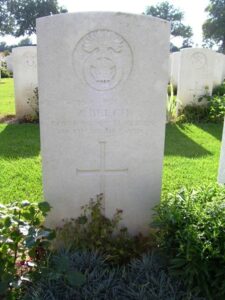
David Thomas Henry Bendle, Private, 18380, Welsh Regiment. David was born at Llansadwrn, the son of James and Eleanor Bendle. The family had moved to Brynawel, Glanamman prior to the war, and David enlisted at Ammanford into the 9th Battalion, Welsh Regiment and landed in France with the battalion on 18 July 1915. David was probably wounded at some time, before returning to France and joining the 2nd Battalion, Welsh Regiment, which was attached to 3 Brigade, 1st Division. The battalion had fought in almost every major action of the war, and was in Flanders when the German offensive hit the area on 9 April 1918. The Division was caught in the Battle of Estaires, but the onslaught was too much, and so the British pulled back, fighting at the Battles of Hazebrouck and of Bethune. David was Killed in Action in Flanders on 23 July 1918 aged 21, and is buried at Cambrin Military Cemetery. His superior officers paid a glowing tribute to his bravery and popularity. David’s parents later retired to Dilkasha, Blackpill, Swansea.
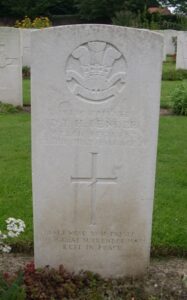
Albert Edward Blackwell, Private, 88338, Royal Army Medical Corps. Albert was the son of William and Emily Blackwell, of Brize-Norton, Bampton, Oxon. He worked for the Great Western Railway, and was based at Garnant with the Signals Department, but entrained for Swindon after the outbreak of war, where he enlisted into the Royal Army Medical Corps. Albert was posted to Salonika on 7 January 1917, where he became attached to the 79th Company, Machine Gun Corps, which was part of the 27th Division. Albert became ill and died in Salonika of myelitis on 25 May 1917. He was 27 years old, and is buried at Salonika (Lembet Road) Military Cemetery, Greece.
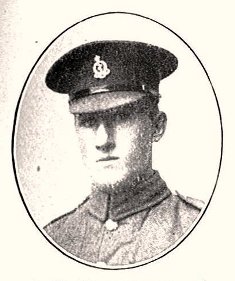
James Ernest Chapman, Private, 20054, Welsh Regiment. James was born in London in 1893. He looks to have been raised in homes at Bath and Newport prior to gaining work as a gardener. By 1911 he was residing at Brynamlwg, Mountain Road, Brynamman. He enlisted into the 15th Battalion, Welsh Regiment, which formed part of 114 Brigade, 38th (Welsh) Division. In the summer of 1915 the Battalion moved with the remainder of the Welsh Division to Morn Hill Camp, Winchester, where it completed its training and equipping, and embarked for France from Folkestone on 5 December 1915, disembarking at Boulogne the same day. During the winter and spring of 1916 the Battalion held nearly every section of the British line from Givenchy on the La Bassée Canal to Laventie, about six miles South of Armentières. At the end of May 1916, the Battalion moved South with the remainder of the 38th (Welsh) Division to the Somme area, in readiness for the First Battle of The Somme, which commenced on 1 July 1916. The 38th Division were tasked with the taking of the infamous Mametz Wood. The first attack on Mametz Wood was on 7 July, when the division lost heavily in ‘Death Valley’ during the advance on the ‘Hammer Head’. The next attack went in on 10 July, and after heavy fighting the wood was cleared, but at the cost of over 5,000 casualties in the 38th (Welsh) Division. James was killed in Action in Mametz Wood on 11 July 1916, aged 22. He is buried in Caterpillar Valley Cemetery, Longueval.
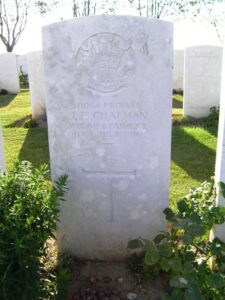
George Cook, Private, 18320, Worcestershire Regiment. George was the son of John and Sarah Cook, of Greenfield Cottage, Garnant, and he enlisted at Pontardawe into the 11th Battalion, Worcestershire Regiment, which was attached to 78 Brigade, 26th Division. The Division landed at Boulogne on 23 September 1915 but were soon moved again, arriving in Salonika during November that year. Here they fought in the Salonika Campaign against the combined Bulgarian and Turkish forces. George was killed in action in Salonika, during the Battle of Doiran on 25 April, 1917, aged 23. He is remembered on the Doiran Memorial, Salonika.
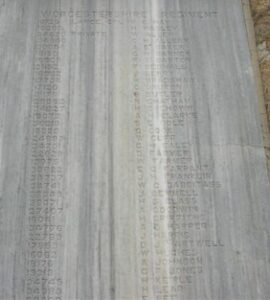
John William Crump, MM, Sergeant, 12094, Worcestershire Regiment. John was the son of John and Ada Crump, of Woodland Villa, Twyn, Garnant. He was a regular soldier, and was serving prior to 1911 with the Worcestershire Regiment, which was stationed at Dover Castle. At the outbreak of war John was posted to the 4th Battalion, Worcestershire Regiment, which was attached to 88 Brigade, 29th Division. The Division moved to Gallipoli via Egypt, landing on 25 April 1915. They remained here until evacuation to Egypt on 11 January 1916 and then moved to the Western Front on 15 March 1916. The Division took part in its first major action in France during the 1916 Somme Offensive, and fought at the Battles of Albert and Le Transloy, suffering heavy casualties. John was awarded the Military Medal for Bravery on the Field during the Battle of the Somme, and the award was listed in the London Gazette of 5 January 1917. In the spring of 1917 the 29th Division fought at the Battle of the Scarpe, which was part of the Arras Offensive, and then moved further north to Ypres. Here they fought at the Battle of Langemarck, where John was killed in action on 16 August 1917, aged 23. He has no known grave, and so is remembered on the Tyne Cot Memorial, Belgium.
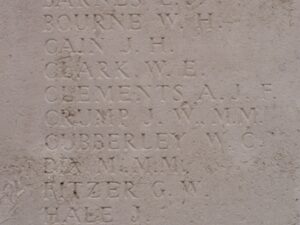
Aaron Davies, Private, 20812, Royal Warwickshire Regiment. Aaron was born in Glanamman, the son of Morgan and Ann Davies. The family later moved to Gellygron, Pontardawe, and Aaron married there, before moving with his wife Harriet Davies, to 18, Tan-y-Fron, Garden Suburb, Barry. Aaron enlisted at Swansea into the Welsh Regiment, and later transferred into the 1/5th Battalion, Royal Warwickshire Regiment, who were attached to 143 Brigade, 48th (South Midland) Division. The Division was a formation created by the establishment of the Territorial Force in 1908. It moved to France between 22 March and 1 April 1915, and saw its first major engagement at the opening of the Battle of the Somme. The Division held the line between the 56th (London) and the 31st Divisions, both of which were heavily engaged at Gommecourt and Serre respectively. Two of the battalions of the Division attacked on 1 July 1916, and suffered heavy casualties. They then went into action at the Battle of Bazentin, during the second phase of the Battle of the Somme, and captured Ovillers. Aaron was killed in action at Bazentin Ridge on 18 July 1916, aged 27. He has no known grave and so is remembered on the Thiepval Memorial, France.
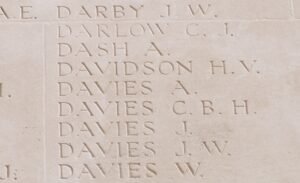
Charles Campbell Davies, Driver, W/1359, Royal Field Artillery. Charles was the son of Owen and Anne Davies, of Towyn, Merioneth. He married Annie Jones at Dolgellau in 1906 and the couple moved to Mirion House, Gelly Road, Glanamman, where Charles worked as a plasterer. He enlisted at Aberdare into the Welsh Divisional Artillery and served in France with D/122nd Brigade, Royal Field Artillery from 24 December 1915. Charles saw action at Mametz Wood with the Welsh Division the following year and also took part in the artillery support for the divisions’ assault on Pilckem Ridge. He was killed in action during the Battle of Langemarck on 16 August 1917, aged 31, and is buried in Bard Cottage Cemetery, Belgium. Charles is not commemorated locally.
David Oscar Tyrell Davies, Sapper, 192048, Royal Engineers. David was the son of Ben and Nella Davies of Garnant. He had worked as a postman at Worcester prior to the war, and served during the Great War with the Royal Engineers Signal Service, A.E. Cable Company. David had served in Salonika before becoming ill, and he died of Malaria at Bedford Military Hospital on 24 November 1918 aged just 21. He is buried at Garnant (Christ Church) Churchyard.
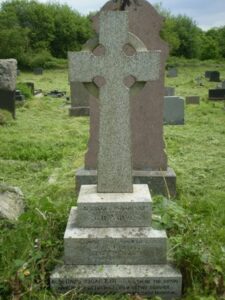
James Ernest Davies, Private, 5949, Royal Warwickshire Regiment. James was the son of John Isaac and Anne Davies, of 2, Castle Street, Llandovery. He had worked at Cwmaman prior to enlisting at Carmarthen into the 4th Welsh, before being transferred into the 2/7th Battalion, Royal Warwickshire Regiment. The battalion was attached to the 61st (South Midland) Division, and moved to positions at Fleurbaix for its trench initiation, relieving the 38th (Welsh) Division, which was moving to the Somme. On 19 July 1916 the 61st Division took part in the infamous diversionary attack at Fromelles, and was almost wiped out. James was killed in action at Fromelles on 19 July 1916, aged 25. He has no known grave, and is remembered on the Loos Memorial, France. He is one of a number of soldiers who died in the battle that may have been buried in mass graves by the Germans afterwards.

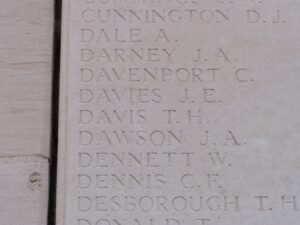
John Davies, Private, 19109, Somerset Light Infantry. John was the Husband of Emily Davies, of Bryngrenig, Glanaman, and enlisted at Ammanford into the army. He was posted to the 8th Battalion, Somerset Light Infantry, which was attached to 63 Brigade, 21st Division. The Division crossed to France between 2 and 13 September, 1915, and its first experience of battle was calamitous, being in France for only a few days, lengthy forced marches brought it into the reserve for the British assault at Loos, where it was sent into action on 26 September, and suffered over 3,800 casualties for very little gain. They moved to the Somme in 1916, and fought at the Battle of Albert. John was killed in action during the opening day of the Battle of the Somme, on 1 July 1916. He is buried at Gordon Dump Cemetery, Ovillers La Boiselle, France.

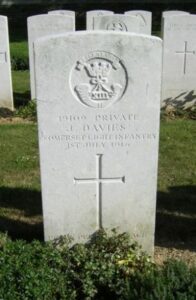
Llewelyn Davies, Private, 12225, Royal Welsh Fusiliers. Llewellyn was the son of Henry and Anne Davies, of Glynaber, Twyn, Garnant. He enlisted at Ammanford into the 8th Battalion, Royal Welsh Fusiliers. The Battalion was attached to 40 Brigade, 13th (Western) Division. On 13 June 1915 the Division sailed to Alexandria, and from there landed at Cape Helles, Gallipoli, and relieved the 29th Division. The Division saw much action at Gallipoli, taking part in the Battles of Sari Bair, Russell’s Top, and Hill 60, ANZAC. Soon afterwards the Division was transferred from ANZAC to Suvla Bay, and it was evacuated from Suvla on 19 December 1915, when the infantry moved after a weeks rest to the Helles bridgehead, where they faced the last Turkish attacks at Helles. On 8 January 1916, the Division was evacuated from Helles, and by 31 January was concentrated at Port Said, where they held forward posts in the Suez Canal defences. On 12 February 1916 the Division began to move to Mesopotamia, to strengthen the force being assembled for the relief of the besieged garrison at Kut al Amara. By 27 March, the Division had assembled near Sheikh Saad and came under orders of the Tigris Corps, and then took part in the attempts to relieve Kut. However, after these efforts failed and Kut fell, the British force in the theatre was built up and reorganised. Llewellyn was taken ill during the expedition into Iraq, and died there from fever on 9 May 1916. He is buried at the now devastated Basra War Cemetery, Iraq. His brother Richard also fell.
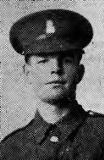
Richard Davies, Gunner, 77856, Royal Garrison Artillery. Richard was the son of Henry and Anne Davies, of Glynaber, Twyn, Garnant. He enlisted at Ammanford on 8 May 1916 into the Royal Artillery, and was posted to the RGA Depot in France on 4 August 1917. From here, Richard was posted as a reinforcement to the 76th Siege Battery, Royal Garrison Artillery. The battery was in the St. Quentin sector early in 1918, and was hit by the German Spring Offensive, which was launched there on 21 March 1918. After two days heavy fighting, Richard was mortally wounded, and died on 23 March 1918 at the 1/3rd Highland Field Ambulance. Richard was 24 years old. He was buried at Villers Brettonneux Military Cemetery, Fouilloy, France. His brother Llewellyn also fell.
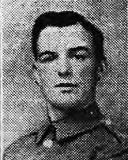
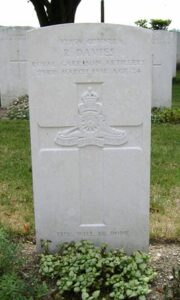
Thomas Davies, Gunner, W/3379, Royal Field Artillery. Thomas was the son of David Rees Davies, and Ann Davies, of 6, Evans Terrace, Glanamman. He enlisted at Swansea into the Welsh Divisional Royal Field Artillery, and landed in France on 23 December 1915. At some time later, Thomas was posted to ‘B’ Battery, 307th Brigade, Royal Field Artillery, which was attached to the 61st (2nd South Midland) Division. The Division had been in France since May 1916, and had been decimated during the attack at Fromelles. It didn’t see further action until following the German retreat to the Hindenburg Line in March 1917. Later that year it fought at the Third Battle of Ypres. The Division then moved south, where it was to take part in the Battle of Cambrai, between 20 November and 7 December 1917. In late November 1917, the British Third Army made a highly successful attack, using massed tanks for the first time, near Cambrai. 61st Division was initially held in reserve and was still in the area when the enemy made a determined counterattack on 30 November. The Division was ordered up to reinforce the units under attack in the area of La Vacquerie and for some days was involved in a hard fight to stem the enemy attack. During March 1918 the Division faced the might of German Spring Offensive, at the Battle of St Quentin, which is where Thomas was killed in action, on 21 March 1918, aged 24. He has no known grave, and so is remembered on the Pozieres Memorial, France. Mant thanks to Bill Davies for the photograph of his uncle Tom.
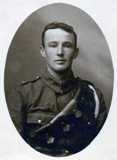
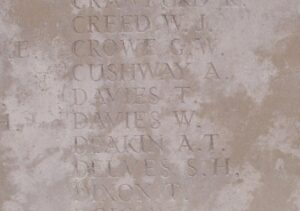
Thomas Davies, Private, 88592, Royal Welsh Fusiliers. Thomas was born in Cwmllynfell in 1893. By 1911 he was living with his adopted parents, Joseph and Eleanor Jones, at Maesyderi, Glanamman. Thomas enlisted at Carmarthen into the army and late in 1918 was posted to France, joining the 16th Battalion, Royal Welsh Fusiliers, who were attached to 113 Brigade, 38th (Welsh) Division. The Division had been in France since December 1915 and had famously captured Mametz Wood in 1916 and Pilckem Ridge in 1917. The division played a major part in the great offensive across the Somme battlefields from 21 August 1918 onwards, and drove the Germans back to and beyond the Hindenburg Line. Thomas was killed in action during the Battle of the Sambre, on 4 November 1918, aged 25. He is buried at Englefontaine British Cemetery, France.
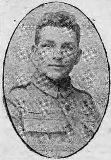
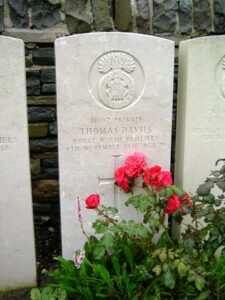
Robert Docherty, MM, Sergeant, 79729, Royal Engineers. Robert was born at Larkhall, Lanarkshire on 5 May 1878, the son of Daniel and Janet Docherty. He was a miner and married Davina McGregor at Auchderterran, Fife on 25 March 1904. By 1911 the couple had moved to Eglwysilan with their young daughter Elizabeth and soon afterwards moved to Garnant, where Robert had found work. He appears to have been an army reservist who re-enlisted at Bridgend at the outbreak of war and was posted to France on 17 December 1914 with the 2nd Battalion, Cameron Highlanders, which was attached to 81 Brigade, 27th Division. The division took part in the Second Battle of Ypres the following year before moving to Salonika. Robert remained in France, however, and transferred to the 258th Tunnelling Company, Royal Engineers following its formation at Rouen in April 1916. The company moved into the Hill 70 sector near Loos-en-Gohelle, joining the 173rd Tunnelling Company and began tunnelling in the Hill 70 and Double Crassier area. Robert was awarded the Military Medal soon afterwards ‘for his fine work in tunnelling and defeating the enemy.’ He was among a number of casualties suffered by his company when their mine was counter-mined by the Germans in October 1916, but was rescued, dying of his wounds at No 1 Casualty Clearing Station on 22 October 1916, aged 38. He is buried in Chocques Military Cemetery, France. His daughter Elizabeth was awarded his MM in a ceremony at Garnant in 1919, shortly before she moved back to Fife with her mother. Robert does not appear to be commemorated locally.
Hugh Doherty, Sergeant, 41726, Royal Field Artillery. Hugh was born at Hardwick, Manchester, and was son of John and Marian Doherty, of 6, Worcester Place, Swansea. He had worked at Garnant as a Clerk prior to the war, and enlisted at Swansea on 5 October 1914 into the Royal Artillery, and was posted to France on 20 July 1915 to join the 90th Brigade, Royal Field Artillery. In September 1916 Hugh transferred to “C” Battery, 92nd Brigade, Royal Field Artillery. The battery moved to Ypres in 1917, and took part in the initial bombardments of the Battle of Passchendaele. Hugh was killed at Ypres on 20 July 1917, and is buried at Canada Farm Cemetery, Belgium.
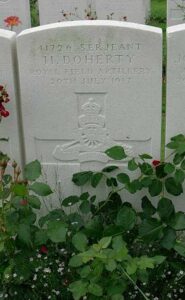
Owen Ivor Ellis, Private, PO/15659, Royal Marine Light Infantry. Owen was born on 11 March 1893, the son of Owen and Catherine Ellis, of Rhiw Bryfdir, Blaenau Festiniog. He had lived with his sister Elizabeth at Ynys Domlyd House, Glamnamman prior to enlisting into the Royal Marines, and by the outbreak of war was serving aboard HMS Bulwark. On 26 November 1914 Bulwark was at anchor off Sheerness when a massive internal explosion ripped through her, tearing the ship apart and sinking it with the loss of 736 men. Owen was 21 years old and is commemorated on the Portsmouth Naval Memorial, England. Owen is not commemorated locally.
Alfred Elwell, Serjeant, 36452, Royal Field Artillery. Alfred was born at Small Heath, Birmingham, the son of Thomas Elwell. He had served with the Royal Engineers prior to the war, but had retired from the army, becoming an annealer at the Glanamman Tinworks, living with his wife Phoebe Elwell, at Ynysceffyl House, Glanamman. He enlisted at Birmingham into the Royal Field Artillery in August 1914, and was posted to France to join the 71st Battery, 36th Brigade. Alfred was killed in action by shellfire during the Battle of Passchendaele, on 24 October 1917. He was 30 years old, and is commemorated on the Tyne Cot Memorial, Belgium.
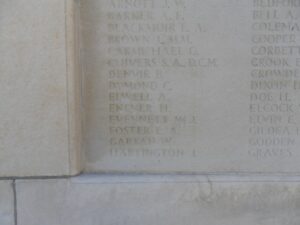
David John Evans, Private, 75286, Welsh Regiment. David was the son of James and Gwen Evans, of Waunhen, Cwmgarw Road, Brynamman. He enlisted at Cardiff into the 15th Battalion, Welsh Regiment, which formed part of 114 Brigade, 38th (Welsh) Division. In the summer of 1915 the Battalion moved with the remainder of the Welsh Division to Morn Hill Camp, Winchester, where it completed its training and equipping, and embarked for France from Folkestone on 5 December 1915, disembarking at Boulogne the same day. During the winter and spring of 1916 the Battalion held the line in French Flanders, and then moved south to the Somme, where they fought at Mametz Wood. After a year in reserve, they fought at Pilckem Ridge and Langemarck in Third Ypres, and were back on the Somme in 1918 facing the German Offensive. After playing a leading role in pushing the Germans back in late 1918, David was killed in Action at the Battle of the Selle on 23 October 1918 aged just 20. He is buried at Rocquigny-Equancourt Road British Cemetery, Manancourt, France.
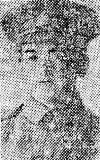
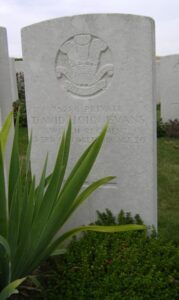
Evan James Evans, Private, 6360, Royal Welsh Fusiliers. Evan was known as Jim, and was the son of David Evans, of Bristol House, Cymmer, Port Talbot. Prior to the war he resided with his wife Louisa Evans, at 3, Greenfield Road, Twyn, Garnant. He was an army reservist and re-enlisted at Neath on 28 October 1914 into the 3rd Battalion, Royal Welsh Fusiliers. After a brief period of retraining, he was posted to France on 4 December 1914, joining the badly depleted 2nd Battalion, Royal Welsh Fusiliers, which was attached to 19 Brigade. The Brigade had fought at the Battle of Mons, and during the epic retreat through Solesmes, Le Cateau to the Marne, where the BEF stopped the German attack in its tracks. They then took part in the advance to the Aisne, before transferring to the 6th Division and moving to positions east of Ypres. On 31 May 1915 the Brigade moved to the 27th Division, and fought at Second Ypres, and then transferred to the 2nd Division for a short period, fighting with them at the Battle of Loos. On 25 November 1915 the Brigade transferred again, to the 33rd Division in the Loos area, where Jim was killed in action on 22 June 1916, aged 28. He has no known grave, and is remembered on the Loos Memorial, France.
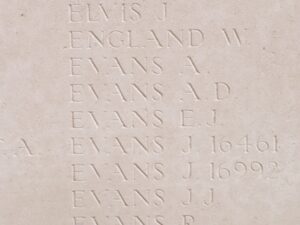
Evan William Evans, Gunner, 3010, Royal Field Artillery. Known as William, Evan was the son of John and Elizabeth Evans, of Garnant Terrace, Garnant. He enlisted at Cwmamman into the Welsh Divisional Royal Field Artillery, and landed with the division in France on 23 December 1915. At some time after, William was posted to their ‘X’, 42nd Trench Mortar Battery, which was attached to the 42nd (East Lancashire) Division. On 6 May 1915 the Division landed at Cape Helles, Gallipoli, where they fought until evacuation in January 1916. They then spent twelve months in Egypt again, and were moved to the Western Front in February 1917, taking over the line near Epehy then Havrincourt. In September they moved north to Ypres, where they fought through Third Ypres, until moving to the Coast in September to refit. November 1917 saw them moving to positions at Givenchy, where they remained until moving back south in early 1918. Here they faced the German Spring Offensive of 21 March 1918 on the Somme, and fought in the Battle of Bapaume, and then at Arras. The offensive stalled for several months, and the Division remained on the Somme, where William was killed in action on 30 June 1918, aged 23. He is buried at Bertrancourt Military Cemetery.
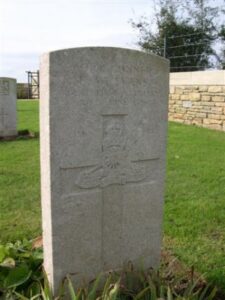
Joseph Evans, Thomas Evans and William Evans. The original roll of Cwmamman’s fallen, which was published in the Amman Valley Chronicle of 7 July 1919 contains these three men, Joseph, Thomas and William Evans. None of these three men can presently be positively identified.
Joseph Evans, Private, 9132, Royal Welsh Fusiliers. Joseph was the son of John and Margaret Evans, of Drefach, Llandeilo. He had served with the 3rd Volunteer Battalion, Welsh Regiment for three years around the turn of the century before enlisting Cardiff on 23 June 1906 into the 2nd Battalion, Royal Welsh Fusiliers. Joseph was recalled to the battalion from the Army Reserve after the outbreak of war. The battalion landed at Rouen on 11 August 1914. On 22 August they became attached to 19 Brigade, which was under independent control, and fought at the retreat from Mons to the Marne. The professional soldiers of the BEF stopped the German Advance in its tracks at the Marne, and followed their withdrawal to the Aisne, where another Battle was fought. Now that the German advance toward Paris had been stopped, 19 Brigade was attached to the 6th Division, and moved to Ypres, where it remained until 31 May 1915, when it was transferred to the 27th Division, and fought at Second Ypres. On 19 August they moved to the 2nd Division, and fought with them throughout the Battle of Loos. On 25 November they moved again, to the 33rd Division, and it was during the first winter with this new Division that Joseph was wounded on 17 January 1916. He was brought to a Casualty Clearing Station at Bethune, where he Died of Wounds on 29 January 1916, aged 30. Joseph is buried at Bethune Town Cemetery, France.
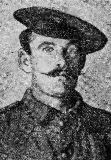
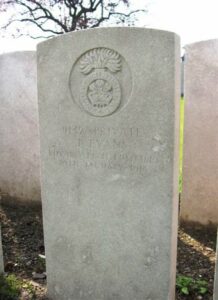
Samuel Fish, Private, 27849, Welsh Regiment. Samuel was the brother of Henry Fish, of Cwmgrenig, Glanamman. He worked at the Duffryn Amman Colliery prior to the war, and enlisted at Ammanford into the 18th Battalion, Welsh Regiment, who were attached to 119 Brigade, 40th (Bantam) Division. The Division moved to France in June, 1916 and took over positions in the line near Loos, where they remained until moving to the Somme later that year, where they fought at the Battle of the Ancre. They spent their first winter in the trenches of 1916/17 on the Somme, which is where Samuel was killed in action on 30 December 1916, aged 27. He was buried at Priez Farm, which was destroyed by gunfire later in the war, and so he is remembered by a Special Memorial at Guards Cemetery, Combles.
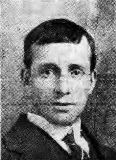
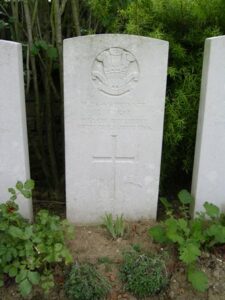
David Griffiths, Corporal, 26029, Northumberland Fusiliers. David was the son of William and Catherine Griffiths, of Varteg House, Garnant. He had been born at Pontypridd, but the family had moved to Garnant prior to 1901 to find work in the mines. David had enlisted at Ammanford into the Army, and was posted to the 10th Battalion, Northumberland Fusiliers, which landed in France in August 1915 as part of 68 Brigade, 23rd Division. They saw their first major action at the Battle of Albert in July of the following year, where they captured Contalmaison, and then fought at the Battle of Bazentin, the Battle of Pozieres, the Battle of Flers-Courcelette, the Battle of Morval and the Battle of Le Transloy, where they captured Le Sars. David was killed here on 4 October 1916. He was 28 years old and is commemorated on the Thiepval Memorial, France. There is another memorial to his memory on the base of his younger elder brother Gwilym’s headstone at Hen Bethel Chapel, Glanamman.
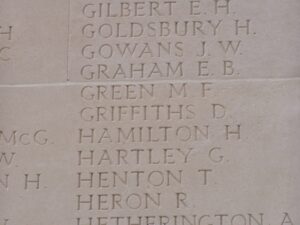
David Griffiths, Lance Corporal, 13977, Royal Welsh Fusiliers. David was the son of William and Mary Ann Griffiths, of 2, High Street, Glanamman. He enlisted at Ammanford into the 10th Battalion, Royal Welsh Fusiliers, who were attached to 76 Brigade, 25th Division and landed in France on 27 September 1915. In October the Brigade transferred to the 3rd Division. They were stationed at Ypres at the time, and in 1916 fought there at the Actions of the Bluff, and at the St Eloi Craters. They were then moved south to the Somme, where they were to take part in the great Battle of the Somme, and fought there at the Battle of Albert, and at the Battle of Bazentin, where they captured Longueval. They then took part in the Battle of Delville Wood, and the Battle of the Ancre, before settling into another bleak winter in France. In May 1917 the Division were at Arras, and fought at the First and Second Battles of the Scarpe, and at the Battle of Arleux and the Third Battle of the Scarpe, where they captured Rouex. Again they moved, this time back to Ypres, where they fought in the Third Battle of Ypres, at the Battle of the Menin Road and the Battle of Polygon Wood. In November the Division moved south again, where they fought at the Battle of Cambrai, and they were in the area during March 1918 when the German Spring Offensive swept through the British lines, at the Battle of St Quentin and the First Battle of Bapaume. They then fought at the First Battle of Arras, before being moved to Flanders to rebuild. However the Germans switched the focus of their offensive to Flanders, and the Division were caught up in the worst of the fighting there, at the Battle of Estaires, and then at the Battles of Hazebrouck and Bethune. By now the German offensive had stalled, and the Division were moved south to take part in the great British offensive, and on 21 August 1918 fought at the Battle of Albert, where David was killed in action on 24 August 1918. He was 24 years old and is buried at Delville Wood Cemetery, Longueval, France.
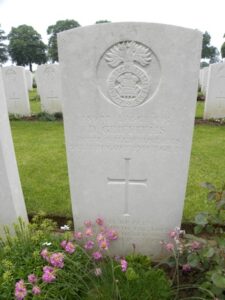
Charles Ivor Hayward, Private, 13986, Royal Welsh Fusiliers. Ivor was the son of Thomas Brown Hayward and Ruth Hayward, of The Bungalows, Garndiffaith, Pontypool. His mother had died in 1889, and his father remarried, before moving the family to 9, Tycoed Road, Glanamman prior to 1911, where he worked as a carpenter. Ivor enlisted at Ammanford into the 11th Battalion, Royal Welsh Fusiliers, which was attached to 67 Brigade, 22nd Division. The Division crossed to France in September 1915, and on 27 October 1915 the Division embarked for Salonika. It completed concentration there in November, and took part in the Retreat from Serbia during December 1915. Ivor then fought at the battle of Horseshoe Hill, and the battle of Machukovo. He died of wounds as a result of the latter on 5 November 1916. Ivor was 22 years old, and is buried at Karasouli Military Cemetery, Greece.
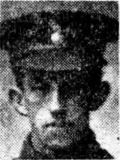
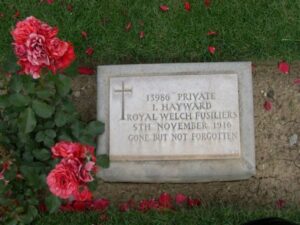
Lewis Holt, Private, 17809, Welsh Regiment. Lewis was born in Garnant, the son of John and Mary Jane Holt. After his father’s death his mother moved the family to Oakfield, Lower Cwmtwrch, Swansea. Lewis enlisted at Ystalyfera into the 14th Battalion, Welsh regiment, attached to 114 Brigade, 38th (Welsh) Division. The Division had landed in France during December 1915 and had spent their first winter in the trenches near Armentieres. In June they marched south to the Somme, where they were tasked with the capture of Mametz Wood. The attack on the wood began on 7 July, but met with fierce resistance, and it took until 11 July to clear the wood. Lewis was wounded during one of the attacks, and was brought to the Casualty Clearing Station at Heilly for treatment. He died of wounds there on 24 July 1916, aged 22, and is buried at Heilly Station Cemetery, Mericourt-L’Abbe.
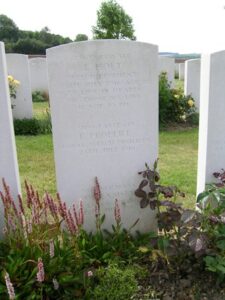
Arthur Hopkins, Corporal, 12146, Royal Welsh Fusiliers. Arthur was the son of Hopkin and Anne Hopkins, of Neath. He had resided at Glanamman for several years prior to the war, and had married Elizabeth Mary Lewis, of Amman Cottage, Glanamman in 1911. Arthur enlisted at Ammanford into the 8th Battalion, Royal Welsh Fusiliers. The battalion was attached to 40 Brigade, 13th (Western) Division, and sailed for the Mediterranean on 13 June 1915. During July the division landed at Cape Helles, Gallipoli and relieved the 29th Division, before being transferred to the ANZAC sector the following month. On 8 January 1916, the Division was evacuated from Helles, and concentrated at Port Said, where they held forward posts in the Suez Canal defences. On 12 February 1916 the Division began to move to Mesopotamia, to strengthen the force being assembled for the relief of the besieged garrison at Kut al Amara. By 27 March, the Division had assembled near Sheikh Saad and came under orders of the Tigris Corps, and then took part in the attempts to relieve Kut. However, after these efforts failed and Kut fell, the British force in the theatre was built up and reorganised. The Division then fought at the Battle of Kut al Amara, from December 1916 to February 1917, which is where Arthur was killed in action on 25 January 1917, aged 27. He has no known grave, and so is remembered on the Basra Memorial, Iraq.
William Henry Hurley, Gunner, 463, Royal Garrison Artillery. William was the son of Thomas James Hurley and Mary Ann Hurley (nee Jones). The family had lived at Tenby for several years prior to moving to 1, Arcade Terrace, Garnant. William enlisted at Swansea into the Royal Garrison Artillery, but sadly died at Pembroke on 27 May 1915, aged 23. He is buried at Pembroke Dock Military Cemetery.
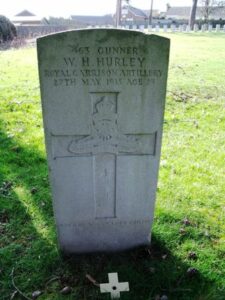
Stanley Garfield Jenkins, Private, 31143, Royal Welsh Fusiliers. Stanley was the son of Evan and Esther Jenkins, of Broadawel, Twyn, Garnant. He enlisted at Maesteg on 1 June 1915 into the 16th Battalion, Royal Welsh Fusiliers, who were attached to 113 Brigade, 38th (Welsh) Division. Stanley sailed with the Division for France on 2 December 1915. The division moved to the Nursery Sector near Fleurbaix, to be initiated into trench warfare in a ‘quiet’ sector of the line. On 17 February 1916 the battalion took over the front line positions at Hamilton Terrace and Fife Street, and within the coming days were subjected to sporadic rifle grenades, fired from the German lines. Stanley was killed by a grenade on 19 February 1916, aged 22. He is buried at Guards Cemetery, Windy Corner, Cuinchy, France.
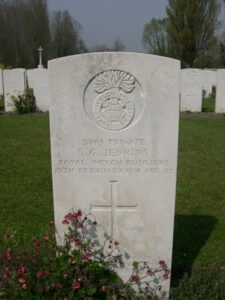
Benjamin Thomas Jones, Private, 38726, Yorkshire Regiment. Benjamin was born at Capel Isaac, the son of Thomas Jones. His mother had died by 1901, and in 1908 his father remarried, moving the family to 15, Gelly Road, Glanamman. Benjamin enlisted at Neath into the army, and was posted to France at some time in 1916, joining the 10th Battalion, Yorkshire Regiment, which was attached to 62 Brigade, 21st Division. The division moved to the Somme in 1916, and fought throughout the offensive, wintering on the Somme before moving to Arras in April 1917. Benjamin was killed in action during the First Battle of the Scarpe, on 11 April 1917, aged 26. He is commemorated on the Arras Memorial, France. Benjamin is not commemorated locally.
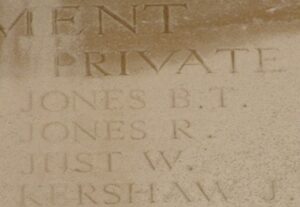
David Aaron Jones, Private, 320357, Welsh Regiment. David was the son of John and Elizabeth Jones, of Cribyn, Cardiganshire. He worked at Garnant prior to the war and enlisted at Carmarthen into the Pembroke Yeomanry. During March 1916 the 1/1st Pembroke Yeomanry moved to Egypt, where it merged with the Welsh Border Mounted Brigade and formed the 4th Dismounted Brigade. On 2 February 1917 it merged with the 1/1st Glamorgan Yeomanry to form the 24th Battalion, Welsh Regiment, and became attached to 231 Brigade, 74th (Yeomanry) Division. The Division had formed in Egypt in January 1917 and had fought through the Palestinian Campaign, at the Battles of Gaza and the Battle and capture of Jerusalem. David was killed in action 31 October 1917, aged 24. He is buried in Beersheba War Cemetery, Israel.
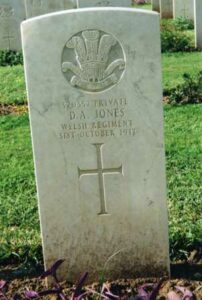
Evan John Jones, Private, 27180, South Wales Borderers. Evan was the son of William and Alice Jones, of Prospect Place, Garnant. He enlisted at Neath into the 1st Battalion, South Wales Borderers, which were part of 3 Brigade, 1st Division. The Division moved to France on 13 August 1914 and moved to positions around Mons, where they fought in the Battle of Mons, and in the epic retreat from Mons to the Marne, where the German Offensive was stopped. The BEF then followed up the German withdrawal to the Aisne, and met them in battle again, before moving to Ypres, where they again stemmed the German attack there. After a hard first winter on the Western Front, the Division fought at the Battle of Aubers in May 1915, and then at the Battle of Loos in September. They remained in positions around Loos until late June, 1916 when they were moved to the Somme, but Evan was killed in action before the move, on 9 June 1916 aged 26. He is remembered on the Arras Memorial, France.
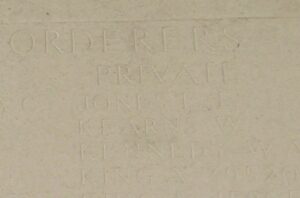
Maurice Jones, Corporal, 3397, Welsh Regiment. Maurice was born in Tregaron, and was the Husband of Sarah Anne Walters (formerly Jones), of 39, Harold Street, Tirydail, Ammanford. He enlisted at Ammanford into the 1/4th Battalion, Welsh Regiment, which was attached to 159 Brigade, 53rd (Welsh) Division. The Division moved to the Mediterranean, sailing from Devonport in July 1915 arriving at Mudros by 5 August 1915. From here they moved to Gallipoli, landing on 9 August. Here they were immediately thrown into battle, and spent the next few days in isolated pockets, fighting against a Turkish counter-attack. Maurice was killed in action just days after landing, on 10 August 1915. He was 36 years old, and so is remembered on the Helles Memorial, Gallipoli.
Rees Jones, Private, 203373, Welsh Regiment. Rees was born in Llanybydder, and was the brother of David Aaron Jones. He worked at Gwaun-Cae-Gurwen prior to the war and enlisted there into the Welsh Regiment. During 1916 he was posted to the 11th Battalion, Welsh Regiment, and joined the battalion in Salonika. Here he was transferred into the 67th Battalion Machine Gun Corps. Rees died in Salonika on 6 October 1918. He is buried in Mikra British Cemetery, Kalamaria.
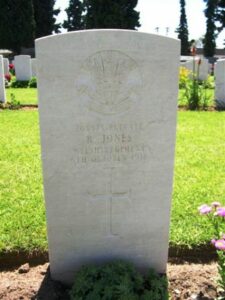
William Enson Jones, Lance Corporal, 20108, Welsh Regiment. William was born at Llandyfriog, and moved to Garnant prior to 1911 to work for the Great Western Railway. He married Hannah Jones (nee Rees), a widowed mother of four young children, in 1910, and the couple resided at Tyddewi, Garnant Road, Garnant. William enlisted at Ammanford into the 15th Battalion, Welsh Regiment, which was known as the Carmarthen Pals battalion. After training at Rhyl and Winchester the battalion moved to France on 2 December 1915 attached to 114 Brigade, 38th (Welsh) Division. William didn’t go out to France with the battalion, but was posted out with a number of reinforcements to the 16th Battalion, Welsh Regiment, which was attached to the same division. He was probably wounded during the battalions gallant attack on Mametz Wood on 7 July 1916, and returned home where he died on 21 July 1916, aged 29. He is buried at Garnant (Old Bethel) Welsh Congregational Chapelyard.
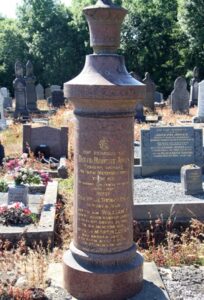
William Henry Jones, Lance Corporal, 13195, Royal Welsh Fusiliers. William was the son of David John and Adeline Jones, of 11, Tircoed Road, Glanamman. He enlisted at Ammanford into the 9th Battalion, Royal Welsh Fusiliers, who were attached to 58 Brigade, 19th (Western) Division. The Division assembled around Bulford during September 1914. Divisional training was completed near Tidworth, from March 1915, and the Butterfly Division crossed to France between 11 and 21 July 1915. It remained on the Western Front throughout the war. The Division fought at the Battle of Loos, and then moved to the Somme, where they took part in the second wave of the attack on Ovillers-La Boiselle on 1 July 1916, capturing the village at heavy cost, and fought through the Somme Battles of Pozieres and the Ancre in 1916. They then moved north to Ypres, where William was wounded. He died of wounds on 7 April 1917, aged 22, and is buried at Mendinghem Military Cemetery, Belgium.
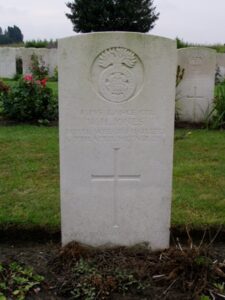
William Howell Jones, Private, 5244, Welsh Regiment. William was the son of Jacob and Anne Jones, of Garnant. Prior to the war he resided with his wife Rachel Annie Jones, at 9 Moelwyn Terrace Garnant. He enlisted at Ammanford into the 1/4th Battalion, Welsh Regiment, who were attached to 159 Brigade, 53rd (Welsh) Division. The Division moved to the Mediterranean, sailing from Devonport in July, 1915 arriving at Mudros by 5 August 1915. From here they moved to Gallipoli, landing on 9 August. Here they were immediately thrown into battle, and spent the next few days in isolated pockets, fighting against a Turkish counter-attack. William was killed in action just days after landing, during the Battle of Sari Bair (Attack on Scimitar Hill), on 10 August 1915, aged 23. He has no known grave, and so is remembered on the Helles Memorial, Gallipoli.
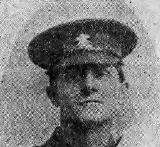
William John Jones, Gunner, W/2985, Royal Field Artillery. William was the son of John and Letitia Jones, of Norton Bridge, Pontypridd, Glam, and the Husband of Ethel Mary Jones, of Maerdy Fach, Ffairfach, Llandeilo. He enlisted at Pontypridd into the Royal Field Artillery, and served in ‘B’ Battery, 122nd Brigade, which was attached to the 38th (Welsh) Division. The Division had landed in France during December 1915 and had famously captured Mametz Wood in July 1916 and Pilckem Ridge on 31 July 1917. Following the German Spring Offensive of March 1918 the division was moved to the Somme, and took up positions around Aveluy Wood and Albert, and they remained here for the next few months. The tide of war turned on 8 August 1918 when a gallant Australian Victory at Villers-Brettoneux turned the German attacks, and the Allies started pushing the Germans back over the ground they had taken so spectacularly. The Division fought at the breakout of the Battle of Albert, then at Bapaume, Havrincourt and Épehy, and then the Battles of Beaurevoir and Cambrai, where William was gassed. He was brought to the Base Hospital at Etaples, where he sadly died of Wounds on 8 November 1918, aged 26. He is buried there, in Étaples Military Cemetery, France.
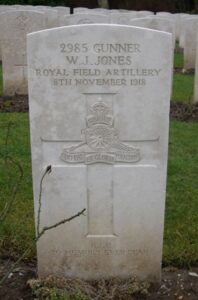
Orlando Leonard, Driver, W/5031, Royal Field Artillery. Orlando was the son of John and Lizzie Leonard, of Penrheol, Garnant. He enlisted at Cross Keys into the Welsh Divisional Royal Field Artillery, but was transferred to the 1st Brigade Ammunition Column, Royal Field Artillery, which was attached to the 27th Division. The 27th Division was formed in England in October-November 1914, from regular units returning from India, Hong Kong and Canada. On 21 December 1914 it landed in France and proceeded to the Western Front, where it fought at the Action of St Eloi, and at The Second Battle of Ypres. In November 1915 the Division moved to Salonika, which is where Orlando was to die of pneumonia on 5 November 1918, aged 22. He is buried at Mikra British Cemetery, Kalamaria.
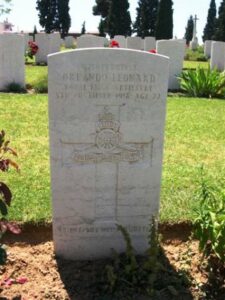
Benjamin Lewis, Lance Corporal, 13685, Royal Welsh Fusiliers. Benjamin was the son of Joseph and Margaret Lewis, of 4, Oak Cottages, Glynmoch, Ammanford. He resided in Garnant prior to the war, and enlisted at Ammanford into the 9th Battalion, Royal Welsh Fusiliers, who were attached to 58 Brigade, 19th (Western) Division. The Division assembled around Bulford during September 1914. Divisional training was completed near Tidworth, from March 1915, and the Butterfly crossed to France 11-21 July 1915. It remained on the Western Front throughout the war. The Division fought at the Battle of Loos, and then moved to the Somme, where they took part in the second wave of the attack on Ovillers-La Boiselle on 1 July 1916, capturing the village at heavy cost. Benjamin was killed in action here on 3 July 1916, aged just 22, and is buried at Ovillers Military Cemetery, France.

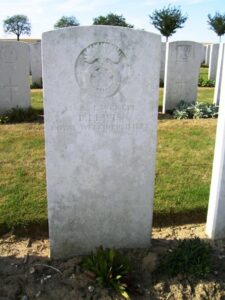
David Lewis, Gunner, W/45, Royal Field Artillery. David was the Husband of Sarah Lewis, of Talafon, Station Square, Pwllheli. They had resided at Glanamman prior to the war, and David had enlisted at Ammanford into the Royal Field Artillery, being posted to the 119th Brigade Ammunition Column, which was attached to the 38th (Welsh) Division. The Division had landed in France during December 1915 and had spent their first winter in the trenches near Armentieres. In June they marched south to the Somme, where they were tasked with the capture of Mametz Wood. The attack on the wood began on 7 July, but met with fierce resistance, and it took until 11 July to clear the wood. The Division suffered terrible casualties at Mametz, and were taken out of the line, and moved to Ypres to rebuild. David must have been sent home suffering from an illness, as he is recorded as having died at home of sickness on 13 September 1917. He is buried at Denio (St. Beuno) Churchyard.
Jacob Dilwyn Llewellyn, Private, 125837, Machine Gun Corps. Jacob was the son of William and Ann Llewellyn, of Rhianfa, Garnant. Jacob had qualified with a B.A., 1st class honours in French before enlisting at Neath into the Royal Welsh Fusiliers. He subsequently transferred to the 19th Battalion, Machine Gun Corps, who were attached to the 19th (Western) Division. The division had crossed to France in July 1915, and had fought at the Battle of Loos in September. During the summer of 1916 it played a large part in the succesful capture of Ovillers-La Boiselle, during the Battle of the Somme. It then moved North to Ypres, taking part in the Battle of Messines, and fought on the Menin Road and at Polygon Wood, before moving up to Broodseinde, Poelcapelle and Passchendaele Village itself. In 1918 they were caught up in the German Spring Offensive near St. Quentin, where they suffered terrible casualties, and fought at the Battle of Bapaume. They moved to Ypres, but were caught up in the German attack at Messines, and at Bailleul, and Kemmel. After suffering terribly again, they moved South to the quieter French sector to rebuild, but were caught up in the German offensive on the Aisne, and fought during the Battle of the Selle, where Jacob was killed in action on 21 October 1918, aged 30. He is buried at Romeries Communal Cemetery Extension, France.
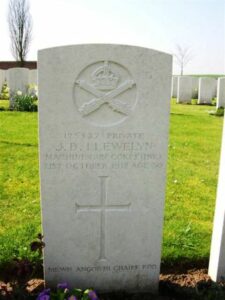
William Henry Lyne, Private, 2439, Monmouthshire Regiment. William was born at Devizes in 1892, and was raised at an orphanage at Bath. He worked at the Raven Tinplate Works at Glanamman prior to the war, and enlisted at Abergavenny into the 3rd Battalion, Monmouthshire Regiment, which was a Territorial Battalion. The Battalion was mobilised for war on 4 August 1914 and moved to Pembroke Dock, then to Oswestry, where the men volunteered for overseas service. On 14 February 1915 the Battalion landed in France, where it joined 83 Brigade, 28th Division, moving to Flanders. In September the Battalion was posted as the Pioneer Battalion to the 49th Division, and moved to the Canal Bank at Ypres. It was here, on 29 December 1915, that William was mortally wounded, when the Germans shelled their positions, wounding over 60 men. William died of his wounds that day, aged 23, and is buried at Ferme-Olivier Cemetery, Belgium (His name is at the base of the headstone). Many thanks to Dave Michael for helping to identify William.
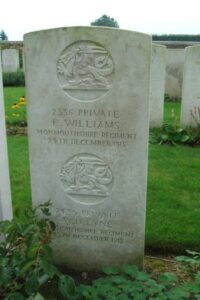
Albert Arthur George Maidment, Pioneer, 192718, Royal Engineers. Albert was the son of Henry and Kate Maidment, of 119, Clyde Road, Tottenham. He worked at Glyndreiniog Nurseries, Glanamman prior to the war and enlisted at Ammanford in November 1914 into the Royal Field Artillery. Albert was later posted on 29 May 1916 to ‘A’ Special Company, Royal Engineers. This was a Gas Company, which specialised in the delivery of poison gas, usually from small cylinders, which would be directed towards the German lines before an assault. Albert was wounded during the Third Battle of Ypres, and died on 23 August 1917, aged 21. He was buried at Lijssenthoek Military Cemetery, Belgium.
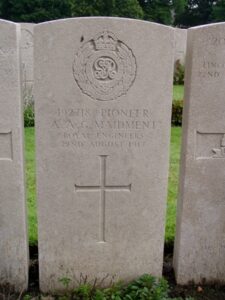
Walter Frank Mason, Private, 31512, Welsh Regiment. Walter was the son of Charles William and Sarah Anne Mason, of Herne Hill, Surrey. Prior to the war he resided at Garnant with his brother Alfred, and married Margaret Jenkins in 1907. The couple set up home at Pedol View, Garnant. Walter enlisted at Ammanford into the 19th Battalion, Welsh Regiment, who was attached to the 38th (Welsh) Division as Pioneers. The Division had landed in France during December 1915 and had spent their first winter in the trenches near Armentieres. In June they marched south to the Somme, where they were tasked with the capture of Mametz Wood. The attack on the wood began on 7 July, but met with fierce resistance, and it took until 11 July to clear the wood. Walter was wounded during the assault and brought back to the Casualty Clearing Station at Heilly, where he died of wounds on 12 July 1916, aged 37. He is buried there at Heilly Station Cemetery, Mericourt-L’Abbe, France.
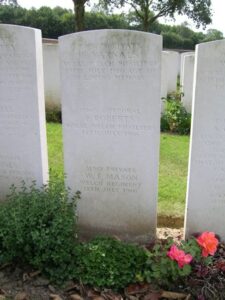
William Idris Morgan, Private, B/20341, Royal Fusiliers. William was the son of David and Rachel Morgan, of Hwyn Neuadd, Twyn, Garnant, and worked as a bank clerk at Cardiff prior to the war. He enlisted at Cardiff into the 26th Battalion, Royal Fusiliers, who were attached to 124 Brigade, 41st Division. This Division was formed in September 1915, and moved to France by 6 May 1916, concentrating near Steenwerck, where they began familiarisation with trench warfare in the areas of Ploegsteert and the Douve valley, south of Ypres. They remained here until August 1916, when they moved to the Somme, and took part in the Battle of Flers-Courcelette. The Division remained in the line, pushing on to Courcelette over the next few days before coming out for a rest and re-fit. They then fought at the Battle of Le Transloy, where William was killed in action on 10 October 1916, aged 21. He is buried at A.I.F. Burial Ground, Flers, France.
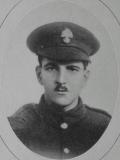
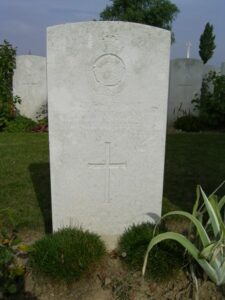
Hugh Morris, Private, 39645, Royal Welsh Fusiliers. Hugh was the son of John and Maria Morris, of Clynderwen. He worked as a Colliery Clerk at Garnant prior to the war, lived at Brynawel, Garnant, and enlisted at Ammanford on 11 December 1915 into the 9th Battalion, Royal Welsh Fusiliers. The battalion was part of 58 Brigade, 19th (Western) Division, and moved to France in July 1915. The Division had fought at the Battle of Loos, and on the opening day of the Somme Offensive, and was posted north to the Flanders sector afterwards, to rebuild its losses. Hugh joined the battalion in Flanders on 11 December 1916. Sadly, he became ill with pneumonia, and was sent to Hospital at Hazebrouck on 28 March 1917. He died there on 5 April 1917, aged 30, and is buried in Hazebrouck Communal Cemetery, France.
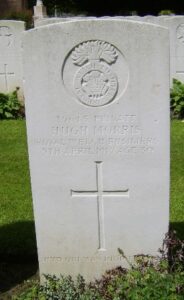
Evan Moses, Private, 12463, Royal Welsh Fusiliers. Evan was the son of Evan and Margaret Moses, of 18, Tinman’s Row, Brynamman. He served in the Royal Welsh Fusiliers during the Great War, and contracted frostbite during service at Gallipoli in 1915. After recuperating in Hospital in Malta, Evan returned to his unit which was now in Palestine, but he contracted Malaria there, and was brought back home for treatment. Evans’ health deteriorated, and he married Mariah Elizabeth Evans at Cardigan on 25 February 1922. Evan died of malaria on 15 December 1922, aged 30, and is buried at Lower Brynamman (Siloam) Baptist Chapelyard, in the grave of his brother Lewis (below). He left a wife and child behind.

Lewis John Moses, Private, 20918, Welsh Regiment. Lewis was the son of Evan and Margaret Moses, of 18, Tinman’s Row, Brynamman. He lived at Bridge House, Glanamman prior to the war and enlisted at Ammanford into the 15th Battalion, Welsh Regiment, which was known as the Carmarthen Pals battalion, attached to 114 Brigade, 38th (Welsh) Division. On 2 December 1915 the battalion moved to France, and the entire Division moved to the Fleurbaix sector, where it was initiated into trench warfare. During June 1916 the Division marched south to the Somme, and on 7 July 1916 attacked Mametz Wood. The initial attack failed, and it was three days later, on 10 July, that a fresh attack was mounted. After two days of heavy hand to hand fighting within the wood, the Germans withdrew. Lewis was wounded during the attack, receiving a gunshot wound to his spine, and was brought home, via the network of Casualty Clearing Stations and Base Hospitals to Southampton. He sadly succumbed to his wounds and died on 4 August 1916, aged 29. His body was brought home to Brynamman, and he was buried on 8 August at Lower Brynamman (Siloam) Baptist Chapelyard. His grave is shared with his brother Evan, who died on 15 December 1922.
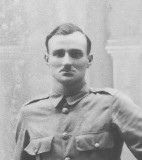
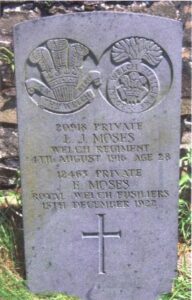
Samuel Nicholas, Private, 39913, Labour Corps. Samuel was the son of William and Anne Nicholas, of Llangennech. He had resided at 66, Pantyffynon Road, Ammanford prior to the war. He enlisted at Ammanford into the 15th Battalion, Welsh Regiment, known as the Carmarthen Pals, but was later posted to the 7th Battalion, Royal Welsh Fusiliers. He must have been wounded at some time, as he was again transferred, joining the 911th Area Employment Company, Labour Corps on 5 February 1917. Samuel was wounded during the German Offensive of spring 1918, and died as a result of his wounds at St. Omer on 31 May 1918, aged 29. He is buried at Longuenesse (St. Omer) Souvenir Cemetery, France. (His name is at the base of the headstone).
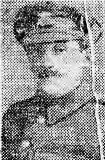
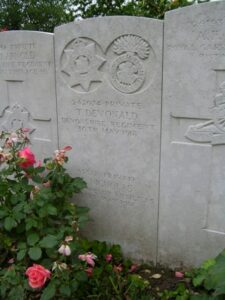
Robert James Peters, Second Engineer, Mercantile Marine. Robert was born at Garnant on 19 August 1886, the son of David and Mary Peters. His father was originally from Milford Haven, but worked for the Great Western Railway, moving the family around west Wales as he progressed in his career. Robert followed his father into the Great Western Railway, becoming an apprentice engineer at Neyland. He then worked for the Mercantile Marine, and had moved to Goodwick prior to the war, serving as Second Engineer aboard the steamship S.S. Inniscara. On 12 May 1918 Inniscarra was en route from Fishguard to Cork, carrying a general cargo, when she was torpedoed and sunk by the German submarine U-86, ten miles off Ballycottin Island, with the loss of 28 lives. Robert was 31 years old when he died that day, and is commemorated on the Tower Hill Memorial, London. Robert does not appear to be commemorated anywhere locally.
Stanley Rees, Private, 30570, South Wales Borderers. Stanley was the son of David and Sarah Ann Rees, of 12, Heollas, Ammanford. He lived at Royal Stores, Garnant prior to the war and enlisted into the South Wales Borderers. Stanley was posted to France in 1917, joining the 2nd Battalion, South Wales Borderers, who had been in France since March 1916 attached to 87 Brigade, 29th Division. In the spring of 1917 they fought at the Battle of the Scarpe, which was part of the Arras Offensive, and then moved further north to Ypres. Here they fought at the Battle of Langemarck, and then at the Battles of the Menin Road, Polygon Wood, Broodseinde and Poelcapelle, before moving to Cambrai. Here they fought at the Battle of Cambrai in November and December, 1917 before moving back to Flanders early in 1918. Stanley was killed in action at Ypres on 12 January 1918, aged 24, and is buried at Cement House Cemetery, Belgium.
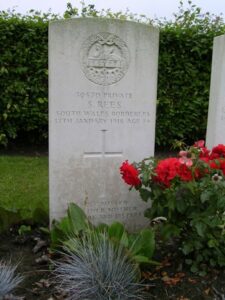
William John Richards, Company Sergeant Major, 62735, Royal Engineers. William was the husband of Megan Richards, of Rock House, Glanamman. He worked as a blacksmith prior to the war and enlisted at Ammanford into the Royal Engineers. William was posted to France on 3 December 1915, and was attached to the 245th Army Troops Company, Royal Engineers, which was the Guernsey Company. William served in France until being wounded, and died of wounds on 17 August 1918, aged 37. He is buried at Esquelbecq Military Cemetery, France.

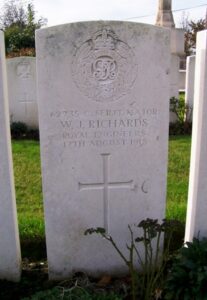
Elias Smith, Private, 12223, Royal Welsh Fusiliers. Elias was the son of Eliada and Margaret Smith, of 5, Brynrhos, Glanamman, and enlisted at Ammanford into the 8th Battalion, Royal Welsh Fusiliers. The Battalion were attached to 40 Brigade, 13th (Western) Division, and on the 13th June 1915 the first transports carrying the Division left port, and moved to Alexandria. By 4 July, all units had moved to Mudros, preparatory for landing on Gallipoli. Between 6 and 16 July 1915 the Divisional infantry landed on Cape Helles and relieved the 29th Division. They left and returned to Mudros at the end of the month, and the entire Division landed at ANZAC Cove between 3 and 5 August 1915, taking part in the Battle of Sari Bair, where Elias was killed in action on 11 August 1915, aged 21. He has no known grave, and so is remembered on the Helles Memorial, Gallipoli.
Edward Taylor, Private, 11836, Welsh Regiment. Edward was born at Bradford, but resided at 2, Railway View, Glanamman prior to the war. He enlisted at Ammanford into the 8th Battalion, Welsh Regiment, which was the Pioneer battalion to the 13th (Western) Division. Towards the end of February the entire Division concentrated at Blackdown in Hampshire, and in June moved to Alexandria, prior to landing on Gallipoli in July 1915, relieving the 29th Division. The Division was evacuated from Helles on 8 January 1916, and concentrated at Port Said, where they held forward posts in the Suez Canal defences. On 12 February 1916 the Division began to move to Mesopotamia, to strengthen the force being assembled for the relief of the besieged garrison at Kut al Amara. By 27 March, the Division had assembled near Sheikh Saad and came under orders of the Tigris Corps, and then took part in the attempts to relieve Kut. However, after these efforts failed and Kut fell, the British force in the theatre was built up and reorganised. The Division then fought at the Battle of Kut al Amara, then at the capture of the Hai Salient and the capture of Dahra Bend. Edward died in Mesopotamia on 14 July 1916, aged 35 and he is buried at Amara War Cemetery, Iraq.
David Thomas, Private, 129351, Canadian Infantry. David was born on 12 August 1890, the son of David and Elizabeth Thomas, of Areulfa, Garnant. He had studied for his B.A. at Cardiff University, before emigrating to Canada, where he took up a post as Teacher at Lord Nelson’s School, Vancouver. David enlisted at Vancouver on 14 September 1915, and was posted to the 16th Battalion (Manitoba), Canadian Infantry, which were attached to 3 (Canadian) Brigade, 1st Canadian Division. The Division had been in France since February 1915 and had seen action at Ypres, at the Battles of Gravenstafel, and at St. Julien, where they plugged the gap left in the line left by the French Colonial Division who had been subjected to the first Gas Attack of the war. They then saw action at the Battle of Festubert, and at Givenchy before moving back to Ypres, where they captured Mount Sorrel in June 1916. The Division then moved south to the Somme, and fought at the Battles of Flers-Courcelette, Thiepval and the Battle of Le Transloy, where David was killed in action on 9 October 1916 aged 26. His body was lost on the battlefield, and so he is remembered on the Vimy Memorial, France. His brother William Michael Thomas also fell.
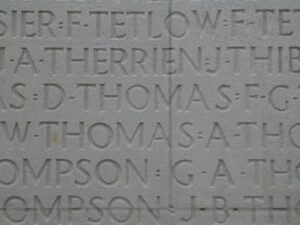
David Morgan Thomas, Private, 201892, Tank Corps. David was the son of David and Ann Thomas of Maesywernen, Glanamman, and worked at Gellyceidrim Colliery before the war. He originally enlisted into the Pembroke Yeomanry, but transferred to the 7th Battalion, Tank Corps in August 1917, taking part in the Battle of Cambrai later that year. David was killed in action during the Kaiserschlacht- The German Offensive, on 12 April 1918, aged 24. He has no known grave, and is commemorated on the Loos Memorial, France. A note in the Amman Valley Chronicle stated that two of his brothers also fell. The only one I can trace is his brother William, who served with the Australian Forces.
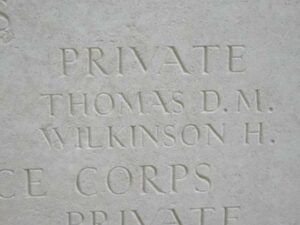
William Thomas, Private, 1369, Australian Infantry. William was the son of David and Ann Thomas, of Maesygwrnen, Glanamman. He trained as an engineer prior to the war, and had also emigrated to Australia. He enlisted at Sydney, NSW on 15 December 1914, into the 13th Battalion, Australian Infantry, who were attached to 4 Brigade, ANZAC Division. The Division moved to Egypt in late 1914, and trained there in preparation for a move to the Western Front. However, the plan was changed and the Australians, as part of the ANZAC Corps, landed as part of the initial assault on the Gallipoli Peninsula on 25 April 1915. William was wounded on 30 August, suffering a gunshot wound to his back, and was evacuated to Hospital in Alexandria. On 13 November he rejoined his Battalion on Gallipoli, and on 3 January 1916 the Battalion were evacuated to Mudros, and then on to Egypt. In Egypt the AIF was doubled, and the Battalions reorganised, seeing the 13th Battalion join the 4th Australian Division. On 1 June 1916 William’s Battalion marched to the harbour in Alexandria, where they embarked on a transport ship for Marseilles, and upon their arrival in France were posted to positions around Fleurbaix. In July the 4th Australian Division moved south to the Somme, to take part in the great offensive there, and on 20 July moved into position at Pozieres. They attacked Pozieres on 23 July, and after a bloody battle, captured the ridge which had held the British 34th Division off previously. The Division were moved from the line to rest at Warloy Baillon, but were moved back into positions north of Pozieres on 14 August, preparatory to an attack on the German strongpoint of Mouquet Farm. William was killed in action here on 14 August 1916, aged 30. His grave was exhumed from Hebuterne after the war, and William is now buried at Serre Road Cemetery No. 1, France. His brother David Morgan Thomas also fell.
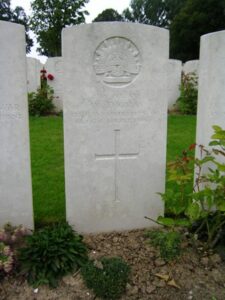
William Albert Thomas, Private, 33674, Welsh Regiment. William was the son of William Jones, of The Globe Inn, Garnant and the Husband of Annie Thomas, of Collier’s Row, Garnant. He enlisted at Brynamman into the 9th Battalion, Welsh Regiment, who were attached to 58 Brigade, 19th (Western) Division. The Division assembled around Bulford during September 1914. Divisional training was completed near Tidworth, from March 1915, and the Butterfly Division crossed to France between 11-21 July 1915. It remained on the Western Front throughout the war. The Division fought at the Battle of Loos, and then moved to the Somme, where they took part in the second wave of the attack on Ovillers-La Boiselle on 1 July, capturing the village at heavy cost. William was killed in action here, during the Battle of Albert, on 7 July 1916. He was 35 years old, and is buried at Serre Road Cemetery No. 1.
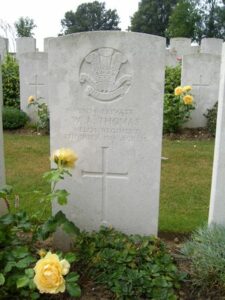
William Michael Thomas, Private, G/23007, Royal West Surrey Regiment. William was born on 23 November 1894, the son of David and Elizabeth Thomas, of Areulfa, Garnant, and enlisted on 1 September 1914 into the Army Ordnance Corps. He later transferred into the 10th Battalion, Royal West Surrey Regiment, who were attached to 124 Brigade, 41st Division. The Division was formed in September 1915, and moved to France by 6 May 1916, concentrating near Steenwerck, where they began familiarisation with trench warfare in the areas of Ploegsteert and the Douve valley, south of Ypres. They remained here until August 1916, when they moved to the Somme, and took part in the Battle of Flers-Courcelette. The Division remained in the line, pushing on to Courcelette over the next few days before coming out for a rest and re-fit. They then fought at the Battle of Le Transloy, before moving to positions south of Ypres in 1917. Here they took part in the Battle of Messines, before moving further north, where they fought at the Battle of Pilckem, and the Battle of the Menin Road where William was killed in action on 20 September 1917, aged 23. He has no known grave, and so is remembered on the Tyne Cot Memorial, Belgium. His brother David was also killed, while serving with the Canadian Infantry.
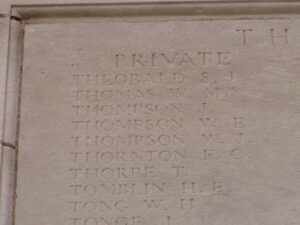
Thomas Windle, Private, 8764, Welsh Regiment. Thomas was born in Liverpool on 26 October 1886, the son of George and Margaret Windle. He was working as a farm servant at Dryslwyn Fawr, Llangathen by 1901. Thomas married Esther Rees, the sister of Reverend Dyfi Rees, of Cwmamman in 1911, and the couple had two daughters, Mary and Netta. Thomas was a regular soldier who had enlisted at Llandeilo into the 2nd Battalion, Welsh Regiment some years prior to the war. At the outbreak of war the 2nd Welsh was part of 3 Brigade, 1st Division, who were rushed to France in August 1914 and moved to positions near Mons. After fighting at the Battle of Mons, they took part in the epic retreat to the Marne, where the BEF stopped the German Attack in its tracks, and forced them to retreat to the Aisne, where they again engaged them in Battle. Thomas was wounded during the Battle of the Aisne, and Died of Wounds on 15 September 1914, aged 27. He is commemorated on the La Ferté-Sous-Jouarre Memorial, France.
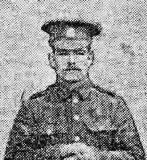
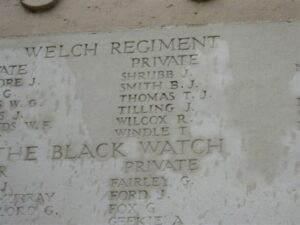
World War Two, 1939-1945
Clifford Ashton, Lance Corporal, Home Guard. Clifford was the son of Edward and May Ashton, of Twyn, Garnant. He served with the 4th Carmarthenshire (Llandilo) Battalion, Home Guard. Clifford died on active service on 1 October 1942, aged 19, and is buried at Garnant (Christ Church) Churchyard. Many thanks to Paul Sambrook for the photograph.
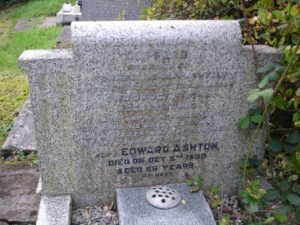
David Bowen, Lance Corporal, 4201869, Royal Welch Fusiliers. David was the son of William and Margaret Ann Bowen, of Garnant, and served with the 7th Battalion, Royal Welch Fusiliers, which was attached to the 53rd (Welsh) Division. The Division landed on the Normandy beaches in June 1944, and took part in the breakout from Normandy, and the drive through France and Belgium into Holland. Between 16 December 1944 and 25 January 1945 the Division fought during the Battle of the Bulge, and advanced into Germany. David was killed in action during the subsequent fighting in the Reichswald Forest on 13 February 1945. He was 27 years old, and is buried at Reichswald Forest War Cemetery, Germany.
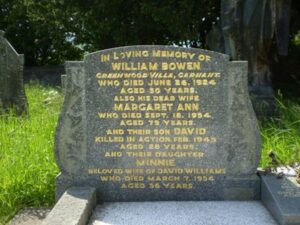
George Cooke, Sergeant, 13062396, Pioneer Corps. George was the son of George and Annie Cooke of Garnant, and the husband of Elizabeth Loraine Cooke, of Ammanford. He served in North Africa with the Pioneer Corps, and died there on 21 July 1943. George was 36 years old, and is buried at Beja War Cemetery, Tunisia.
Mary Doreen Davies (Mollie), Volunteer, W/21697, Auxiliary Territorial Service. Mollie was the Daughter of Handel and Miriam Davies, of Swansea. Mollie was killed, probably during an Air Raid, on 13 February 1940, aged 19, and is buried at Garnant (Christ Church) Churchyard. Her grave is marked by this beautiful marble memorial. Many thanks to Paul Sambrook for sending the photograph in.
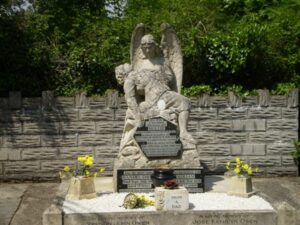
Geoffrey John Garland, Gunner, 3970006, Welch Regiment. Geoffrey served with the 1st Battalion, Welch Regiment, which was stationed at Haifa, Palestine at the outbreak of war. The battalion then moved to Mersa Matruh, in the Western Desert, until being moved to Crete on 16 February 1941. After being almost annihilated during the fall of Crete, the remnants of the 1st Welch were evacuated by 31 May 1941, moving to Sidi Bashir, Alexandria, where it rebuilt and joined the 4th Indian Infantry Division. It then fought in the Western Desert, and it was there that Geoffrey was killed on 29 July 1941 (the CWGC website incorrectly shows 25 September 1942). He was 26 years old, and is buried at Benghazi War Cemetery, Libya.
Kenneth Gwyn Hanham, Ordinary Seaman, Merchant Navy. Kenneth wwas born at Llanedi in 1922, the son of John Hanham and Elizabeth Hanham (nee Evans). He played rugby for Tycoes RFC prior to the war. Kenneth married Catherine Ann Llewelyn, of Glanamman, in 1941, just prior to enlisting into the Merchant Navy. He was posted aboard the SS Sourabaya, a Jersey registered converted whaling ship. She left New York on 18 October 1942, with a cargo of fuel oil, war stores, and 87 passengers, in Convoy HX-212. On 27 October 1942, South-East of Cape Farewell, U-436 fired a spread of three torpedoes into the convoy of which the third torpedo hit the Sourabaya sinking her. Kenneth died that day. He was 20 years old, and is commemorated on the Tower Hill Memorial, London. He was the holder of the King’s Commendation for Brave Conduct.
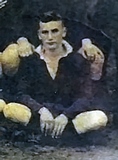
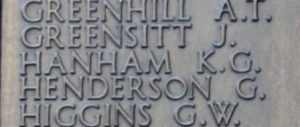
James Landers, Lance Sergeant, 2717927, Irish Guards. James was the son of Joseph Patrick and Margaret Landers, and the husband of Elizabeth Mary Landers, of Glanamman. He served with the 1st Battalion, Irish Guards, which had taken part in the evacuation from Dunkirk in 1940, then spent two years in Britain before being landed in North Africa in March 1943. The battalion then fought in the Medjez Plain area, and saw much fighting at Djebel bou Aoukaz. The fighting continued for several days with the Irish Guards suffering heavy casualties, one of which was James, who was killed in action on 30 April 1943. He was 29 years old, and was buried at Massicault War Cemetery, Tunisia.
Dilwyn Llewelyn, Pilot Officer (Bomb Aimer), 131972, Royal Air Force Volunteer Reserve. Dilwyn was the son of Thomas and Catherine Gwendoline Llewelyn, of Garnant, and served with the Royal Air Force as a Bomb Aimer. His Squadron is not known, but he must have served with a bomber squadron. Dilwyn was killed when he was shot down over Holland on 27 January 1943, aged 22, and is buried at Bergen-Op-Zoom War Cemetery, Netherlands. A fellow crew member, Ronald Edward Elvin, is buried near him.
Hermas Llewellyn, MM, Lance Corporal, 2136378, Royal Engineers. Hermas was the son of John and Martha Llewellyn, of Bishop Road, Garnant, and served in North Africa with the 275th Field Company, Royal Engineers, which was attached to the 51st (Highland) Division. Hermas was killed in action during the Battle of the Kasserine Pass on 15 February 1943. He was 29 years old, and is buried at Tripoli War Cemetery, Libya. Hermas was the holder of the Military Medal, having been awarded it for his work in Mine Disposal, which was listed in the London Gazette of 11 March 1943.
John Llewelyn, Sergeant (Pilot), 1381320, Royal Air Force Volunteer Reserve. John was born on 16 April 1918, the son of John Morgan Llewelyn and Elizabeth Llewelyn, of Cwmberach Farm, Glanamman. He enlisted into the Royal Air Force Volunteer Reserve at the outbreak of war, and was selected for pilot training. After receiving his initial training in the USA, John returned to Britain, and joined 88 Bomber Squadron, RAF. After completing a full operational tour, he was posted to 19 OTU at RAF Kinloss. On 21 August 1942, John was piloting an Avro Anson, Serial DJ106, which took off on a navigational training flight. Visibility was probably poor, and the aircraft crashed into the top of Ben Macdui in the Cairngorms, killing John and his four crewmen. Their bodies were recovered two days afterwards, three of the men being buried at Kinloss, one at Windermere, and John at Garnant (Old Bethel) Welsh Congregational Chapelyard. Many thanks to John’s nephew, Geraint Llewelyn, for the photograph of John, taken before leaving the family home in 1941.
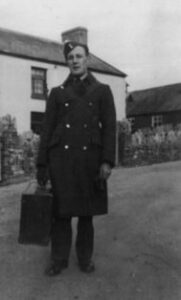
John Howard Morgan, Assistant Steward, Merchant Navy. John served in the Merchant Navy aboard the SS Merel, a London registered steamer. John died when Merel struck a German mine field off the Thames Estuary on 8 December 1939. He was 25 years old, and is commemorated on the Tower Hill Memorial, London.
John Verdun Morris, Craftsman, 3958906, Royal Electrical & Mechanical Engineers. John was the son of Thomas and Margaret Morris; husband of Eunice Mary Margaretta Morris, of Garnant, and served with the Royal Electrical and Mechanical Engineers in North Africa. John was killed in North Africa on 19 May 1943, aged 28, and is buried at Enfidaville War Cemetery, Tunisia.
David George Ronald Phillips, Lieutenant, 245255, Royal Armoured Corps. David was the son of Major Rees Frederick Phillips, M.C., and Iris Phillips, of Glanamman. He was commissioned into the Queen’s Own Royal West Kent Regiment, and served with “B” Squadron, 44th (7th Battalion QORWK) Regiment, which was attached to the Reconnaissance Corps. David saw action in North Africa and Sicily, and took part in the invasion of Italy. He was killed in action in Italy on 19 January 1944, aged 20, and is buried at Minturno War Cemetery, Italy.
Gerwyn Phillips, Flying Officer (Navigator), 153228, Royal Air Force Volunteer Reserve. Gerwyn served with 605 Squadron, RAF, which was equipped with the De Havilland Mosquito, based at RAF Hartford Bridge, Hampshire. The Squadron carried out intruder raids over Germany during the final year of the war, and it was on one such raid that Gerwyn was killed when his aircraft was shot down, in support of the British push through the Reichswald. Gerwyn was buried at Reichswald Forest War Cemetery, Germany
Idwal John Price, Boy 1st Class, D/JX 166627, Royal Navy. Idwal was the son of David Richard and Sarah Jane Price, of Garnant, and was a new recruit into the Royal Navy, serving aboard HMS Gloucester. She was a Town Class Cruiser, which had been commissioned in 1939, and saw service in the Indian Ocean, before joining the Mediterranean Fleet. Gloucester was part of a large Royal Naval presence in the Mediterranean, due to the vitally important need to retain hold of North Africa. Gloucester took part in several engagements after arriving in the Med, but on 20 May 1941 the Germans launched an airborne invasion of Crete, which diverted Royal Naval efforts to attempt to intercept German attempts to aid the invasion by sea. Gloucester was attacked and sunk by German aircraft off Crete on 22 May 1941, whilst attempting to aid another vessel. Idwal was among 722 men lost during the action. He was only 17 years old, and is commemorated on the Plymouth Naval Memorial, Devon.
David John Rees, Sergeant (Air Gunner), 1314623, Royal Air Force Volunteer Reserve. David was the son of David John and Ethel Rees, of Garnant, and served as an Air Gunner with the RAF. Early in 1943 David was posted to 1663, Heavy Conversion Unit, for training in heavy bombers, which was based at RAF Hutton Cranfield. On 6 April 1943, David was one of the crew of a Halifax V, Serial DG143, which took off from Hutton Cranfield at 10.30. After 25 minutes flying, a wing broke off the Halifax, sending it to the ground, some 30 miles east of Rufforth, killing all eight members of her crew. David was 25 years old, and is buried at Port Talbot (Goytre) Cemetery. Many thanks to Neil Smith, 51 Squadron Historian, for the information.
Glyn Price Rees, Engine Room Artificer 4th Class, D/MX 73397, Royal Navy. Glyn was the son of Alfred and Martha Rees, and the husband of Mary Gwendoline Rees, of Glanamman. He served in the Royal Navy aboard HMS Hermione, which was a Dido Class Light Cruiser, which had been commissioned in 1941. Hermione served in the Home Fleet at first, and then took part in escort duties during the Malta Convoys. On 16 June 1942, whilst returning to Alexandria, HMS Hermione was torpedoed by the German submarine U-205, north of Sollum and sank with the loss of 87 of her crew. Among them was Glyn. He was 26 years old, and is commemorated on the Plymouth Naval Memorial, Devon.
Douglas Rowlands, Private, 7371737, Royal Army Medical Corps. Douglas was the son of John and May Rowlands, of Glanamman, and served with the Royal Army Medical Corps. No more is known of him, but he died on active service on 6 March 1945, and is buried at Garnant (Old Bethel) Welsh Congregational Chapelyard.
Edgar Granville Thomas, Trooper, 316958, Royal Armoured Corps. Edgar was the son of Benjamin and Esther Ann Thomas, of Glanamman, and served in North Africa with the Staffordshire Yeomanry, which was part of the Royal Armoured Corps. The Staffordshire Yeomanry fought at the Battles of Alam Halfa and El Alamein, pushing the Afrika Korps all the way into Tunisia. Edgar was killed during the Second Battle of El Alamein on 25 October 1942. He was 31 years old, and is buried at El Alamein War Cemetery, Egypt.
Morgan David Thomas, Leading Aircraftman, 1414728, Royal Air Force Volunteer Reserve. Morgan was the son of Llewellyn and Dinah Thomas, of Glanamman, and served with the RAF. Little more is known of him, but he died on active service on 17 February 1943, aged 21, and is buried at Glanamman (Tabernacle) Presbyterian Chapelyard.
Thomas Yestyn Thomas, Flying Officer (Navigator), 154395, Royal Air Force Volunteer Reserve. Thomas was the son of Haydn Garnant Thomas and Anne Thomas, of Garnant, and served as a Navigator with 550 Squadron, RAF. The Squadron was equipped with the Avro Lancaster II, and was based at RAF North Killinghome. On the night of 3-4 October 1944, Thomas was one of the crew of Avro Lancaster Mk I, Serial NF963, which was badly damaged after returning from a mission over Germany. She broke up in mid air, and dived into the ground near to Ellingstring in North Yorkshire, killing all her crew apart from the pilot, Stanley Hayter, who had managed to parachute out. Thomas was officially recorded as having died on 4 October 1944. He was 22 years old, and is buried at Garnant (Old Bethel) Welsh Congregational Chapelyard.
Daniel Pryce Williams, Sergeant, 970459, Royal Air Force Volunteer Reserve. Daniel was the son of Gwyn R. and Hilda J. Williams, of Garnant, and served with 77 Squadron, RAF, which flew the Armstrong Whitworth Whitley V, based at RAF Topcliffe. Daniel was killed when his Whitley was shot down over Germany on 13 March 1941. He is commemorated on the Runnymede Memorial, Surrey. His fellow crewmen who perished alongside him were Sergeant D. W. Arkwright, Sergeant D. A. Smithies, and Sergeant S. W. Snoddon.
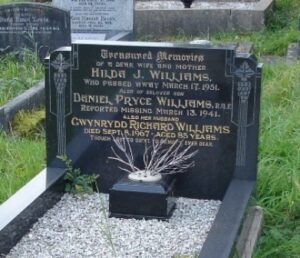
William Llewellyn Williams, Driver, 2351414, Royal Corps of Signals. William was the son of William George and Mary Ann Williams, of Glanamman. William served with the Royal Signals, and died on active service on 9 March 1943, aged 30. He is buried at Garnant (Old Bethel) Welsh Congregational Chapelyard.
Post World War Two
George Royston Evans, Fusilier, 22910228, Royal Welch Fusiliers. George was born at Garnant on 14 June 1935, and served with the 2nd Battalion, Royal Welch Fusiliers. The battalion served during the Malayan Emergency, in support of the Malayan Government against the Malayan Communist uprising. George was killed in Malay on 19 January 1955. He was just 19 years old, and is buried at Cheras Road Christian Cemetery, Kuala Lumpar, Malaysia.